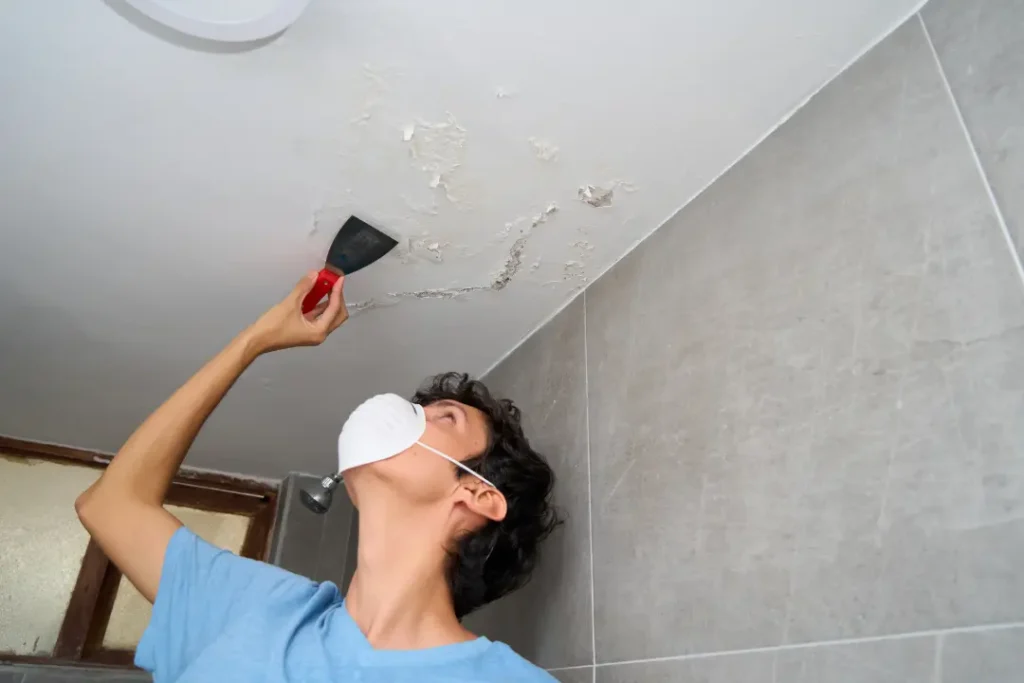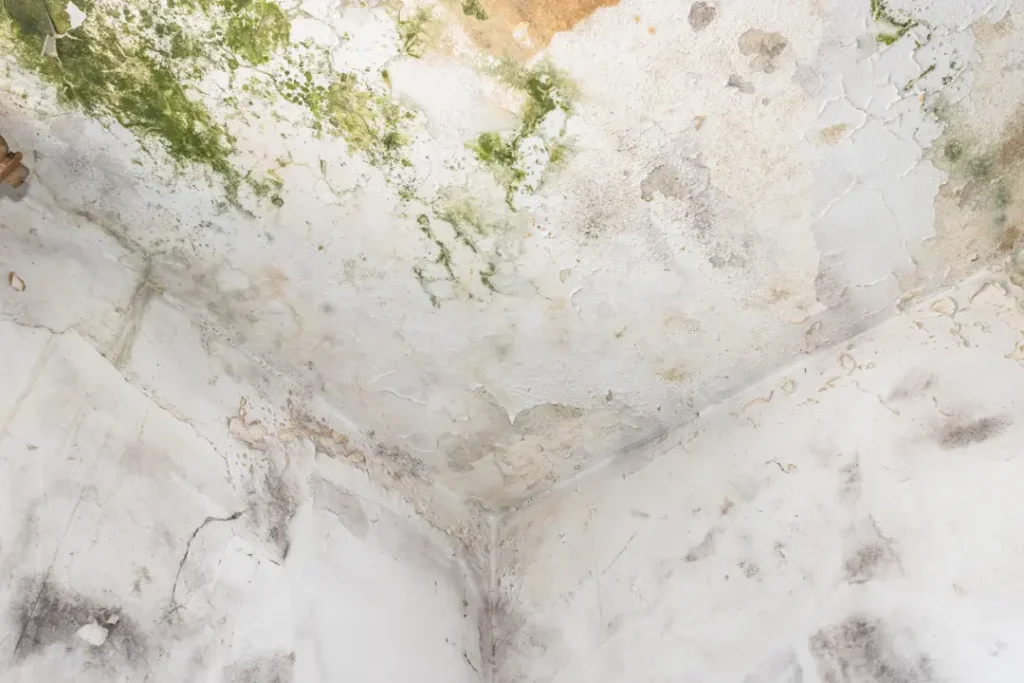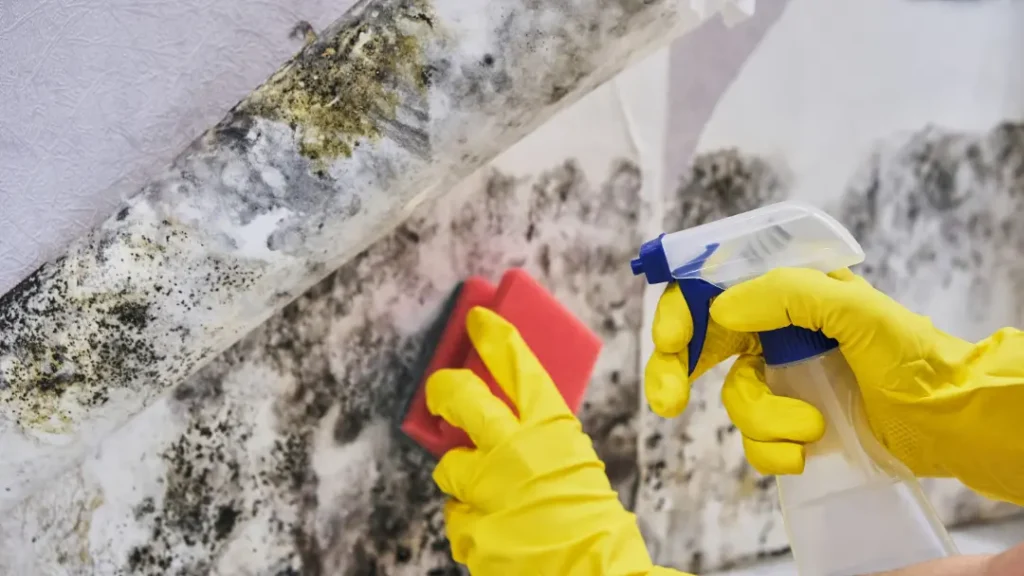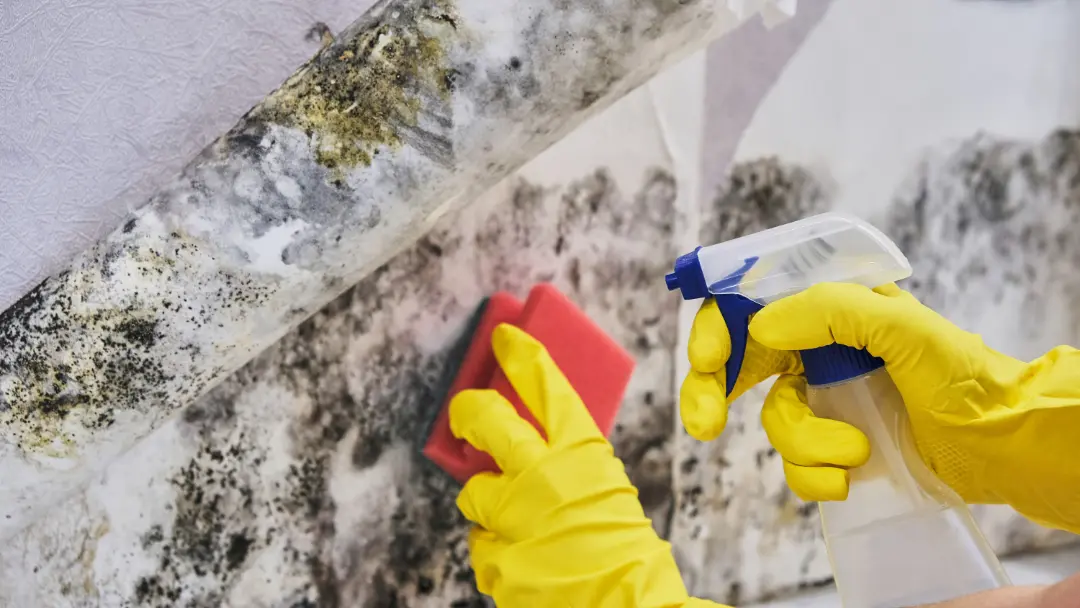Mould on ceilings can cause health problems and property damage. This guide will show you how to remove mould from the ceiling quickly and safely.
You’ll learn how to identify mould, prepare for removal, and use effective cleaning methods. With the right approach, you can restore your ceiling to its former glory and prevent mould from returning.
Key Takeaways
- Identify mould presence by looking for dark stains, musty odours, and paint blistering, especially in damp areas like bathrooms and kitchens.
- Prepare for mould removal by wearing protective gear, gathering proper cleaning supplies, and ensuring good ventilation during the process.
- Use effective mould removal methods such as white vinegar, bleach solutions, or specialist mould sprays, and implement preventive measures to avoid future growth.
Identifying Ceiling Mould
The first step in tackling ceiling mould is identifying its presence. Mould thrives in damp, poorly lit spaces, leading to visible signs such as dark stains on surfaces. A musty odour, reminiscent of wet paper, is also a strong indicator of mould lurking nearby. Beyond these signs, paint blistering on walls can suggest underlying moisture problems that may be related to mould growth. Recognizing these early signs can help you address the issue before it escalates.
Mould commonly grows in areas like:
- Bathrooms, where it is often found over the shower due to steam hitting the cold ceiling, causing condensation
- Kitchens, which can have high humidity levels
- Laundry rooms, where moisture is prevalent

Don’t forget to check for any leaks, whether from plumbing or your roof. Water damage often creates the perfect environment for mould to grow unnoticed.
Taking a closer look at these areas and being aware of the signs can help you catch mould early, stopping it before it causes bigger problems. Even subtle clues like soft spots on bathroom floors or walls can indicate underlying moisture issues, which often lead to mould. Once you’ve spotted the signs, you’re ready to take action.
Preparing to Remove Mould
Preparation is key to safe and effective mould removal. First and foremost, protect yourself. Mould can irritate your lungs, skin, and eyes, so always wear a mask, goggles, and gloves before you begin. With your safety gear on, gather the cleaning supplies you’ll need: a scrub brush, a bucket for your cleaning solution, and a damp cloth for wiping down the area afterwards.
The cleaning solution can be as simple as a bleach-and-water mix or a more natural remedy like vinegar and water. Make sure you have fresh, clean clothing to change into after cleaning and wash any soiled clothes thoroughly to avoid spreading spores around the house.
Good ventilation is also crucial. Open your windows and doors to allow fresh air to circulate while you clean. This will help minimise your mould exposure and ensure a healthier environment.
How to Remove Mould from Ceilings
Once you’re all set up, it’s time to choose a method for removing the mould. There are a few effective options available, and each has its own advantages. No matter which method you use, always prioritise safety. Ensure your ladder is stable, and don’t forget to wear your goggles to protect your eyes from any falling mould spores. Also, check that the cleaning solution you’re using won’t damage your ceiling material.
Here are three reliable methods you can use, depending on the severity of the mould problem:

White Vinegar
White vinegar is a popular and effective solution for killing mould spores without the harshness of bleach. Mix white distilled vinegar with water and spray it directly onto the mould using a spray bottle. This approach is gentle on surfaces, making it a safer option for different ceiling materials.
For stubborn mould, first apply the vinegar to the area. Then, use a brush to scrub it. The acidity of the vinegar helps break down the mould, making it easier to remove. Let the vinegar sit for around an hour before wiping the area with a damp cloth to ensure all mould spores are killed and to kill mould.
White vinegar not only removes mould effectively but also prevents its return due to its antifungal properties. This eco-friendly method is excellent for tackling mild to moderate mould problems on ceilings.
Cleaning with Bleach Solution
Using a bleach solution is a common and powerful method for removing mould from ceilings. For regular infestations, mix one part bleach with ten parts water. For more severe infestations, use a mixture of equal parts bleach and water. This solution is highly effective in killing mould on hard surfaces like tiles but should be used cautiously on porous materials.
Apply the bleach solution to the affected area using a spray bottle and let it sit for at least 30 minutes. This waiting period allows the bleach to penetrate and kill the mould spores effectively. Wearing safety gear, including gloves and goggles, is crucial when handling bleach to prevent respiratory problems and skin irritation.
Wipe the area with a clean, damp cloth to remove any remaining mould and bleach residue after the bleach has done its work. Multiple applications may be needed to ensure complete removal and prevent regrowth.
Specialist Mould Spray
Specialist mould sprays can be the solution for stubborn mould that resists traditional cleaning methods. These sprays tackle tough mould spots without the need for scrubbing. Particularly effective for quick removal, they are often used in more severe cases of mould infestation.
Apply the specialist mould spray evenly to the affected area using a spray bottle. Let the spray sit for about thirty minutes to penetrate the mould thoroughly. This method works effectively not only for ceilings but also for other surfaces where mould may be present.
Clean the area with a damp cloth to remove the dissolved mould and any remaining spray after the waiting period. Specialist mould sprays offer a fast and efficient way to clean mould and deal with stubborn mould, ensuring a cleaner, healthier environment.
Preventing Future Mould Growth: The Best Approach
Preventing future mould growth is vital for maintaining a healthy home environment. Keeping indoor humidity levels below 60% is necessary, as mould thrives in humid conditions. A dehumidifier can help maintain these levels by removing excess moisture from the air.
Proper ventilation is also essential. Ensure that bathrooms, kitchens, and laundry rooms are well-ventilated using an extractor fan or by opening windows and doors. Avoid drying clothes indoors in poorly ventilated areas to prevent increased humidity and mould growth.
Using water-resistant materials during construction and applying anti-mould or mildew-resistant paint can greatly reduce the risk of mould. Regular cleaning and maintenance of these areas will help prevent mould from taking hold again, ensuring your home remains mould-free.

Environ Property Services: Trusted and Reliable Experts in London
Removing mould yourself can be a time-consuming and challenging task, especially when dealing with stubborn infestations. That’s where Environ Property Services comes in. Our team specialises in comprehensive mould removal and building restoration, offering solutions tailored to the specific needs of your property.
Whether you’re dealing with a modern home or a heritage building, we combine traditional expertise with cutting-edge technology to deliver high-quality results. Beyond mould removal, we offer services in heritage restoration, damp proofing, and structural repairs—always with an eye for detail and a commitment to preserving your property’s integrity.
Our experience with both contemporary and historic buildings means we’re fully equipped to handle any mould-related issue you may encounter. With Environ, you can rest easy knowing your home is in expert hands.
Frequently Asked Questions
What are the common signs of mould on ceilings?
The common signs of mould on ceilings are dark stains, a musty odour, and blistering paint, typically found in damp, poorly lit areas such as bathrooms and kitchens. Addressing these signs promptly can prevent further damage and health risks.
What can I do to prevent mould from returning?
To prevent mould from returning, maintain indoor humidity below 60%, ensure proper ventilation, and use water-resistant materials. Regular cleaning and applying anti-mould paint will also help keep mould at bay.
How do I remove bathroom ceiling mould?
To remove mould from your bathroom ceiling, start by mixing warm water with either white vinegar or a bleach solution. Apply the solution to the affected area, scrub gently, and let it sit for 30 minutes. Ensure proper ventilation during and after cleaning to prevent future mould growth on bathroom ceilings.
Why should I consider professional mould removal services?
Consider professional mould removal services for their expertise and comprehensive solutions, which ensure your property’s integrity is preserved while effectively addressing mould issues. Their attention to detail guarantees reliable results, whether for contemporary or historic buildings.
Conclusion
Getting rid of mould from your ceiling is crucial for both your health and the structural integrity of your home. By learning to spot the early signs, preparing properly, and choosing the right cleaning method, you can effectively remove mould and keep it from returning. Whether you opt for white vinegar, a bleach solution, or a specialist spray, each method offers its own benefits depending on the severity of the problem.
Prevention is the final step in the process. By controlling humidity, improving ventilation, and using anti-mould materials, you can keep your home mould-free in the long run. If the problem feels too big to tackle alone, Environ Property Services is here to help, offering expert mould removal and restoration services you can rely on.

